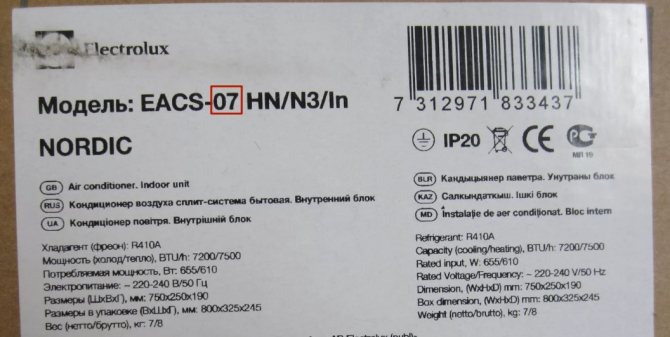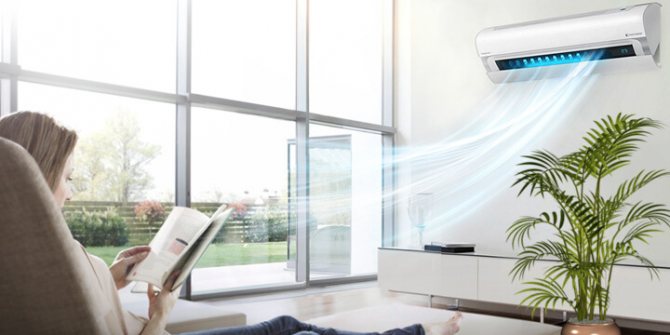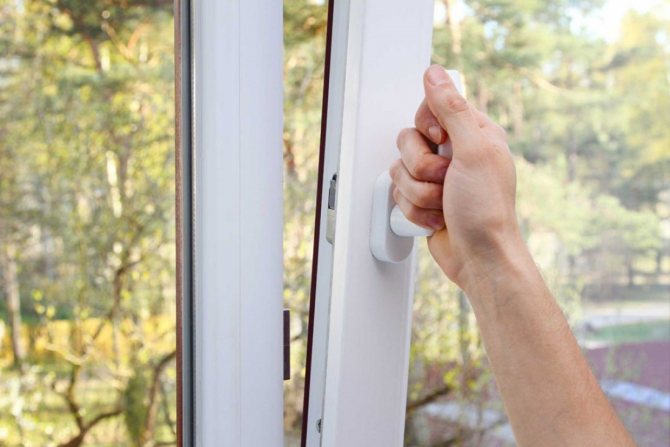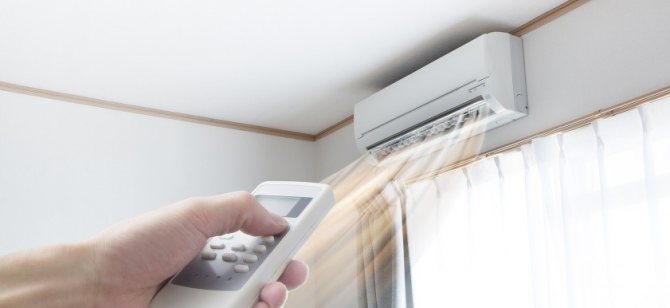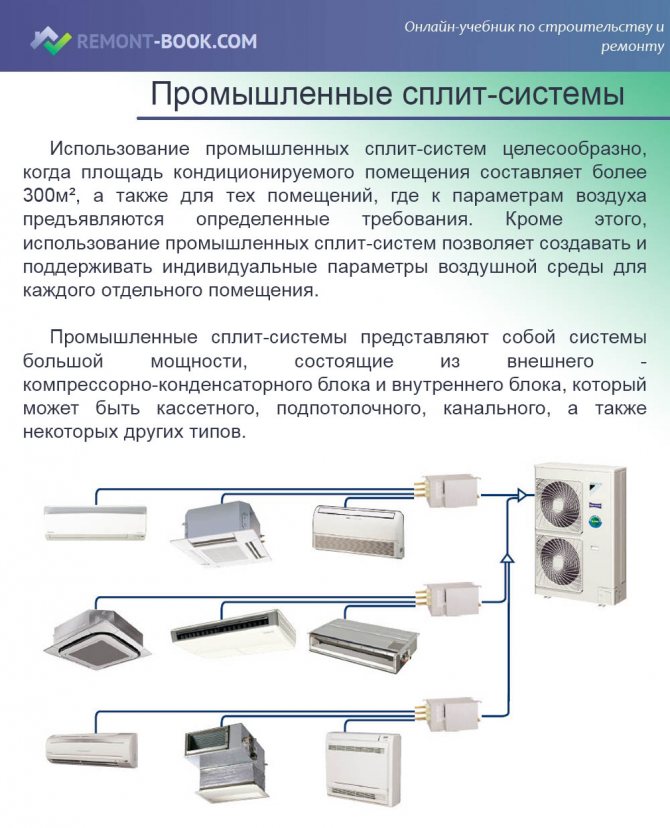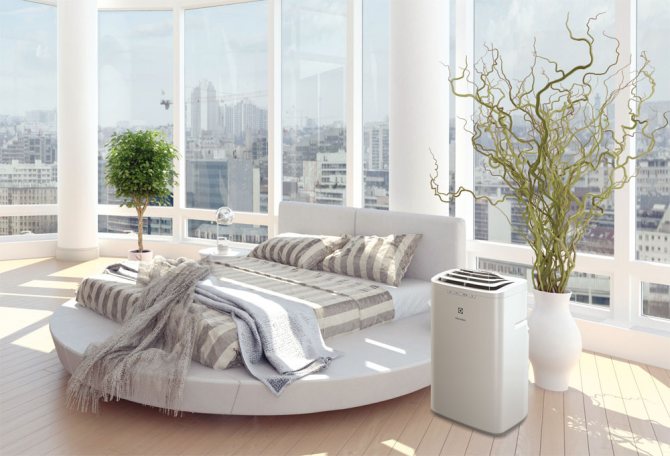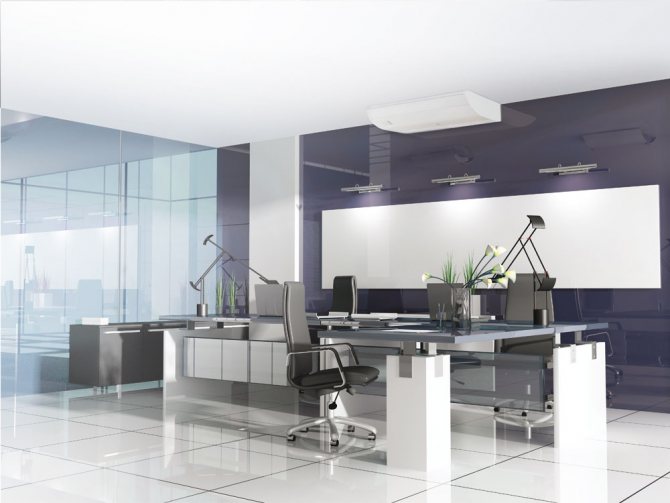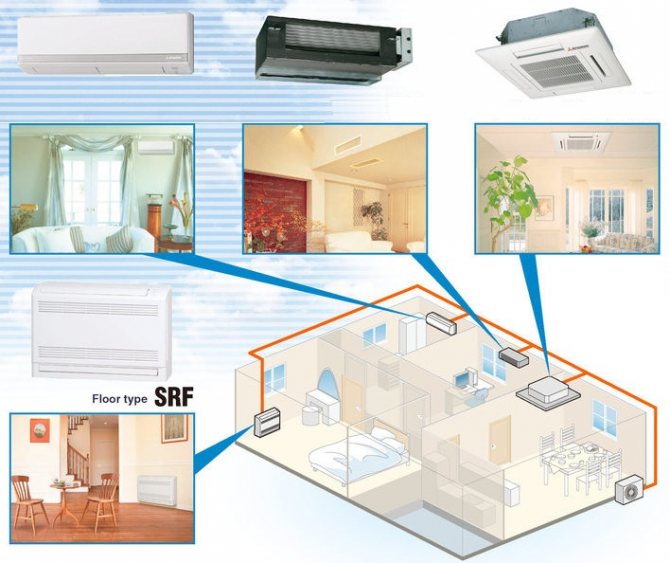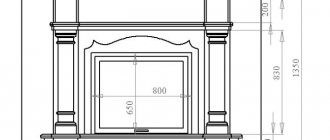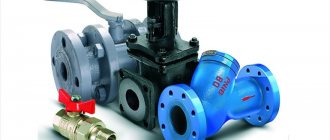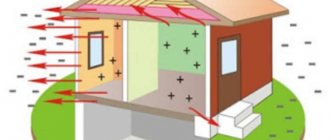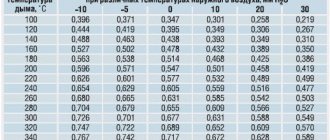Indoor cooling is the main function of the air conditioner, so the choice of air conditioner is primarily determined by the cooling capacity. In turn, the necessary air conditioner capacity directly depends on the size of the room that needs to be cooled.
WITH cooling capacity power consumption should not be mixed as these are completely different parameters. The cooling power is several times higher than the power consumed by the air conditioner. For example, an air conditioner that consumes 700 W has a cooling power of 2 kW, and this should not be surprising, since the air conditioner works just like a refrigerator, a refrigerant (freon) takes heat from the air in the room and transfers it to the outside through a heat exchanger (outdoor unit of the air conditioner) ... The power ratio is called energy efficiency of the air conditioner (EER). For domestic air conditioners, this parameter will have values in the range of 2.5 - 4.
Below is the distribution table capacities air conditioners. According to it, you can select the types of air conditioners that are most optimal in certain conditions. For example, in small rooms or offices where low-power air conditioners are required, it is more rational to install mobile, window or wall models. Air conditioners other models have more power and, accordingly, higher prices, so it is better to purchase them for cooling large premises (sales areas, warehouses, etc.)
| Refrigerating capacity, kW | 1.5 | 2 | 2.5 | 3.5 | 5.5 | 7 | 9 | 10 | 14 | 17 |
| Standard model sizes | 05 | 07 | 09 | 12 | 18 | 24 | 30 | 36 | 48 | 60 |
| Mobile air conditioners (mobile monoblocks and split systems) | ||||||||||
| Window air conditioners | ||||||||||
| Wall-mounted air conditioners | ||||||||||
| Cassette air conditioners | ||||||||||
| Duct air conditioners | ||||||||||
| Column conditioners | ||||||||||
| Floor and ceiling air conditioners |
Power units
Quite often, in addition to the usual power measurement units for us, others are also used. For example, British thermal unit, which is measured in BTU / hr. It is determined by the amount of heat that needs to be heated for one pound of water per degree Fahrenheit.
With the SI system, it has the following relationship:
- 1W = 3.4 BTU / h or
- 1000 BTU / h = 293 W
Quite often, the models are called "nines" or "twelve", since they are marked with the mention of these and other numbers, and the performance is measured in BTU / h.
Operations based on room volume
The most correct calculations of the MO of air conditioners are based on the specific cold parameter per cubic meter of the room. These calculations are especially effective if the area of the room is close to 70 sq. M.
How to select air conditioners according to the area of the room? For operations, specific power is used (letter q). Its values under certain light conditions of the room are indicated in the table:
| Values W / m3 | Light conditions |
| 30 | Shading |
| 35 | Average illumination |
| 40 | Sunny side |
The power to compensate for heat inflows through building components is calculated in this way:
Q1 = q x V, (V is the volume of the room).
With the condition that residents and household appliances are in the room, Q2 (heat from residents according to regulatory documents) and Q3 (heat from household appliances) are added to the calculated value (Q1).
Q3 varies depending on the purpose of the home appliance.
- When the computer is running, Q3 rises by 250-300 watts.
- When office equipment is in operation - by 30% of the absorbed electrical force.
The calculation of the specific power is as follows:
Q = Q1 + Q2 + Q3.
In this example, the ceilings reach 2.7 m in height. The volume is found as follows: 20 (area) x 2.7 = 54 cubic meters.
The average parameter of the specific MO = 35 W / m3. (according to the table).Taking it into account, the operation is as follows: Q1 = 35 x 54 = 1890 W. Q2 and Q3 are added to the result. It turns out:
Q = 1890 + 130 + 300 = 2320 W.
An example of calculating the power of an air conditioner
Let's calculate the capacity of the air conditioner for a living room with an area of 26 sq. m with a ceiling height of 2.75 m in which one person lives, and also has a computer, TV and a small refrigerator with a maximum power consumption of 165 watts. The room is located on the sunny side. The computer and the TV do not work at the same time, as they are used by the same person.
- First, we determine the heat gains from the window, walls, floor and ceiling. Coefficient q
choose equal
40
, since the room is located on the sunny side:Q1 = S * h * q / 1000 = 26 sq. m * 2.75 m * 40/1000 = 2.86 kW
.
- Heat gains from one person in a calm state will be 0.1 kW
.Q2 = 0.1 kW
- Next, we will find heat gains from household appliances. Since the computer and the TV do not work at the same time, only one of these devices must be taken into account in the calculations, namely the one that generates more heat. This is a computer, the heat dissipation from which is 0.3 kW
... The refrigerator generates about 30% of the maximum power consumption in the form of heat, that is
0.165 kW * 30% / 100% ≈ 0.05 kW
.Q3 = 0.3 kW + 0.05 kW = 0.35 kW
- Now we can determine the estimated capacity of the air conditioner:
Q = Q1 + Q2 + Q3 = 2.86 kW + 0.1 kW + 0.35 kW = 3.31 kW - Recommended power range Qrange
(from
-5%
before
+15%
design capacity
Q
):3.14 kW < Qrange < 3.80 kW
It remains for us to choose a model of suitable power. Most manufacturers produce split systems with capacities close to the standard range: 2,0
kW;
2,6
kW;
3,5
kW;
5,3
kW;
7,0
kW. From this range we choose a model with a capacity
3,5
kW.
Interestingly, models from this series are often called "7" (seven), "9" (nine), "12", "18" "24" and even air conditioners are labeled using these numbers, which reflect the power of the air conditioner not in the usual kilowatts, and in BTU / hour
... This is due to the fact that the first air conditioners appeared in the United States, where the British system of units (inches, pounds) is still used. For the convenience of buyers, the capacity of the air conditioner was expressed in round numbers: 7000 BTU / h, 9000 BTU / h, etc. The same numbers were used when marking the air conditioner so that its power can be easily identified by the name. However, some manufacturers, such as Daikin, tie model names to wattage, as the Daikin FTY35 air conditioner has a power of 3.5 kW.
Cooling capacity of air conditioners
To determine the cooling area of the unit, a parameter such as cooling capacity, abbreviated as MO, is used. Very often, consumers confuse it with power consumption, which leads to misconceptions when choosing a technique. Typically, the cooling capacity exceeds the energy consumption by several times. The ratio of these parameters expresses EER - the energy efficiency of the air conditioner. The standard for household appliances can vary from 2.5-4.
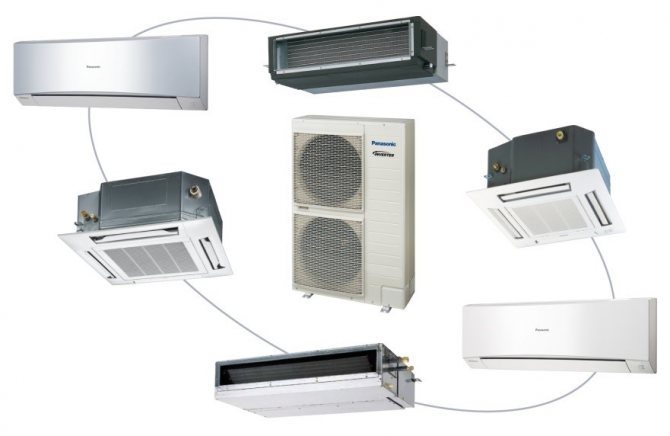
Variety of types of air conditioners
There are several ways to define MO:
- The easiest one is to study the labeling from the manufacturer, comparing the data with the parameters of the room (area), which we will talk about a little later;
- A no more complicated option is to use a special calculator that can be found on the Internet;
- Using formulas, take into account all sources of heat in the room, comparing them with the volume;
- And the most difficult method, close to the scientific approach, is to take into account the heat sources that give energy to the room from the outside, as well as the thermophysical properties of objects in the room.
Of course, no one will use the latter method due to its complexity, and we do not need such accuracy - but comparing the device data not with the area, but the volume of the room will be just right. We will analyze the calculation methodology below.


If the air conditioner does not cope with the cooling, it starts to deliver a lot of inconvenience.
What will happen if the power of the air conditioner is selected incorrectly? It all depends on which direction you made a mistake.If the power is not enough, then the device will not cope with the cooling, the required temperature may not be established, since the heat sources actively oppose the process. At the same time, the air conditioner itself will work for wear - it overheats, which is fraught with premature breakdowns. All this leads to additional expenses for the repair and maintenance of the device.
Find out how to turn on warm air on an air conditioner from different manufacturers in a special article on our portal.
When the air conditioner, on the other hand, is more powerful than necessary, it will not be used to its full potential. Accordingly, you will overpay for the purchase and installation. Such a device in a small room will create a lot of noise. The consequences are not the same as in the first case, but the unpleasant moments always remain so.


It is important to choose the right air conditioner
Additional parameters to consider when choosing an air conditioner
There are many factors that have a significant impact when choosing an air conditioner. First of all, it is necessary to take into account the role of fresh air flow when opening a window. The simplified method for calculating the power of the air conditioner does not take into account the opening of windows for ventilation. This is due to the fact that even in the operating instructions for the system it is indicated that the air conditioner should only operate with the windows closed. In turn, this creates certain inconveniences, since windows can be ventilated only when the device is turned off.
It is not difficult to solve this problem. You can ventilate the room with the air conditioner on at any time, but do not forget to close the front door to the room (so as not to create drafts). It is also necessary to take this nuance into account when calculating the power of the system. To this end Q1
increase by 20% to compensate for the heat load from the supply air. It is necessary to understand that with an increase in capacity, electricity costs will also increase. For this reason, air conditioners are not recommended for use when airing rooms. At the highest possible temperature (summer heat), the air conditioner may not maintain the set temperature, since the heat inflows may be too strong.
If the refrigerated room is located on the upper floor, where there is no attic, then the heat from the heated roof will be transferred to the room. The heat gain of the ceiling will be much higher than that of the walls, so we increase the power Q1
by 15%.
The large area of glazing of windows also plays a significant role. It is quite easy to track this. It is enough to measure the temperature in a sunny room and compare it with the rest. During the usual calculation, it is provided for the presence of this window in the room, with an area of up to 2 m2. If the glazing area exceeds the permissible value. Then, for each square meter of glazing, an average of 100-200 watts is added.
An inverter air conditioner is well suited for operation over a wide range of heat loads. It has a variable cooling capacity, so it is able to create comfortable conditions in a given room.
How to choose an air conditioner by power
Choosing a climate system suitable for your home is a laborious process.


In this case, the following parameters should be taken into account:
- Room area.
- The power level of the device.
- The strength of the existing electrical wiring.
- Ventilation system of the room.
Nevertheless, upon careful consideration of all these parameters, you can find a "golden mean" by choosing the necessary equipment for the home.
For the room
When calculating the cooling capacity of an air conditioner in a room, it is necessary to be guided by the power level of the device. The more acceptable it is, the faster the cooling will take place, which means that the apartment will have an optimal climate.
The performance level of the device in the room depends on the following parameters:
Dimensions and number of windows
Through the glass of window openings, the rays of the sun penetrate inside, heating the air inside the room. Therefore, when selecting the appropriate split system, it is necessary to take into account the window area facing the sunny sides.
Area indicator
According to accepted standards, every 10m2 of room volume requires 1 kW of air conditioner power. If this parameter is not taken into account, the room will have an insufficient or excessive level of cooling capacity. As a result, it will be hot or cold in the room even when the climatic device is in operation!


Number of inhabitants
It is important to keep track of the constant number of people in the room. During the day, the human body is characterized by the release of up to 100 W of heat if it is at rest. With physical activity, this parameter doubles! So, for rooms where at least 2 people are constantly staying, a system with a cooling capacity of at least 200 W of power is needed.
Ceiling level
The calculation of the capacity of an air conditioner for an apartment should be made taking into account the height of the ceilings. When they are located at a level of more than 3 meters, a climate system with a certain margin of refrigeration capacity is required.
Selecting a split system for a room should also be taken into account:
- the appearance of the unit;
- functionality;
- terms of operation.
Note! When choosing a powerful split-system, the level of electricity consumption by it and the cost of utility bills will increase.
It is advisable to choose a climate system for a room, taking into account the number of storeys of the apartment. When placed on the last floors, the temperature inside will always be higher due to the close location of the roof.
You will be interested in: Electricity consumption of the air conditioner


Other area of the room
It is possible to correctly select the climate system for any area of the room using the online calculator available on many sites in the virtual space.
It is very simple to work with it:
- We calculate the area of the required space.
- Find out the height of the ceilings with the number of window openings
- We drive these parameters into certain fields on the screen.
- Clicks on the "calculate" box.
- We get the finished result for a separate building.
There are also special tables to help you choose the right technique for each specific case. Carefully reading their values, you can correctly choose the required power indicator for any room. With the right choice of a split system, you can provide the most favorable temperature for the whole family without overpayments for electricity.
Correspondence of model series and power of the air conditioner in BTU and kW
| The lineup | BTU | kw |
| 7 | 7000 BTU | 2.1kw |
| 9 | 9000 BTU | 2.6kw |
| 12 | 12000 BTU | 3.5kw |
| 18 | 18000 BTU | 5.3kw |
| 24 | 24000 BTU | 7.0kw |
| 28 | 28000 BTU | 8.2kw |
| 36 | 36,000 BTU | 10.6kw |
| 42 | 42,000 BTU | 12.3kw |
| 48 | 48000 BTU | 14.0kw |
| 54 | 54,000 BTU | 15.8kw |
| 56 | 56,000 BTU | 16.4kw |
| 60 | 60,000 BTU | 17.6kw |
Specific conditions for settlements
When calculating MO, it is important to consider the following factors:
- Number of storeys of the room. It can be located on the top floor of a building.
- The presence of non-standard windows. Their glazing can be large-scale. The roof can be transparent to allow light to enter.
- There are many people in the room (workroom, office).
- The room can often be ventilated. It can have significant infiltration of outside air.
- An abundance of household appliances.
- The ceiling, its height and distortions.
In such situations, the estimated efficiency of the air conditioner develops with a coefficient of 1.2 - 1.5.
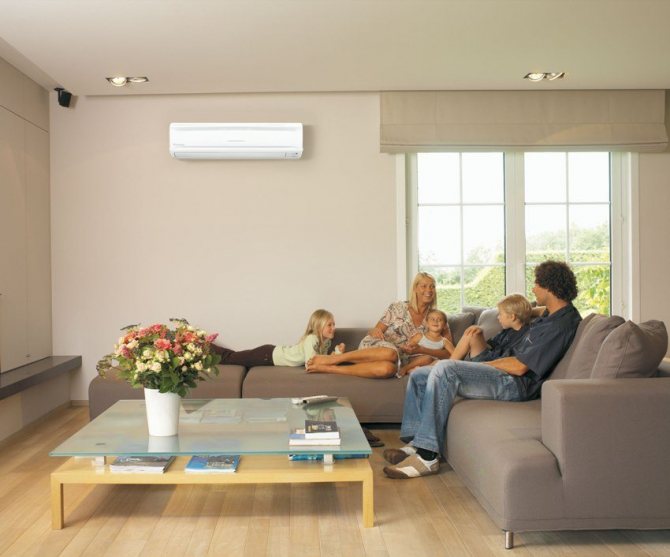

Condition: the window is slightly opened
If you open a window in a room, air from the street appears in it. The documentation for the air conditioner indicates that normal operation is obtained only when the windows are closed. Otherwise, there will be an excess of heat load.
Users switch off the unit from time to time and, after airing the room, restart it to cool down.This causes some inconvenience. He does not work efficiently when the windows are open, that is, provided there is supply ventilation. After all, the volume of air entering the room is not calculated at all. And it is extremely difficult to find out the excess heat load.
Solution: the door closes in the room, the window opens slightly. Drafts are no longer observed in the room, but air in a modest volume is constantly inside.
How the device works in such a condition is not reflected in the documentation for it. And there is a danger that he will not be able to function normally in such a mode. However, in most cases, this measure maintains comfortable cooling in the room. And periodically it is not necessary to ventilate it. And if you intend to use the unit in this mode, please note that:
- The power of Q1 is necessarily increased by 20-25% to compensate for the thermal effect from the air supply. This indicator is a parameter of air exchange (it is reflected in calculators on the network). For residential premises, it lies in the range from 1 to 2.
- The absorption of electricity is developing by 10-15%.
- Sometimes heat inflows are very large, for example, in extreme heat. The device is not able to maintain the required temperature. Then the window must be closed.
- Ideally, it is better to purchase an inverter unit, because it has a variable MO and works effectively at various thermal loads.
Other types of apparatus, even with high power, can create uncomfortable conditions. A small room is the best place to do this.
Calculations using online calculators
The essence of the method is as follows: online calculators are often posted on the websites of air conditioner manufacturers, with their help, the calculation of the refrigerating capacity is very simplified. It is only necessary to enter in the appropriate fields the initial data characterizing the room, the desired air temperature and other parameters at the discretion of the manufacturer, and then press the "calculate" button. That's all, the resulting figure can be safely taken as a basis. More details about this calculation are described in the video:
This is the easiest and fastest method, but it has one drawback: we do not see how the calculation is made and what values of heat input from various sources are included in the program. Sometimes the creators of such resources put too much stock in it, for which you will later have to shell out your money. Therefore, the results of calculations performed using the online calculator will not hurt to check other methods.
Final selection of air conditioner based on capacity
Earlier, an example of mathematical operations was given, as a result of which a parameter of 2.32 kW was obtained. In fact, this is not the final indicator. After all, the necessary apparatus cannot constantly work at the limit of its potential. To arrange its work in a sparing mode, it is necessary to have a power reserve. Usually it is 15-20% of the calculated indicators.
In the example used with the specified values (20 sq.m. living space, 2.7 m, 1 tenant, 1 computer), the calculation formula is obtained:
2.32+ 15% = 2.67 kW.
Many companies manufacture their devices in accordance with the gradation in force in the United States. It is based on the British Heat Unit (BTU). It correlates with the standard values as follows: 1000 BTU / h = 293 watts.
The technical documents for the air conditioner reflect the parameter indicating the capacity in thousands of BTU. The start of the gradation is 7. This is equivalent to 7000 BTU or 2100 watts.
The following is a table of the power of the devices. It reflects the ratio of BTU to standard units. It also indicates the approximate square of the rooms in which each cooler from the line can be installed.
This table can be used for augmented air conditioner capacity calculations.
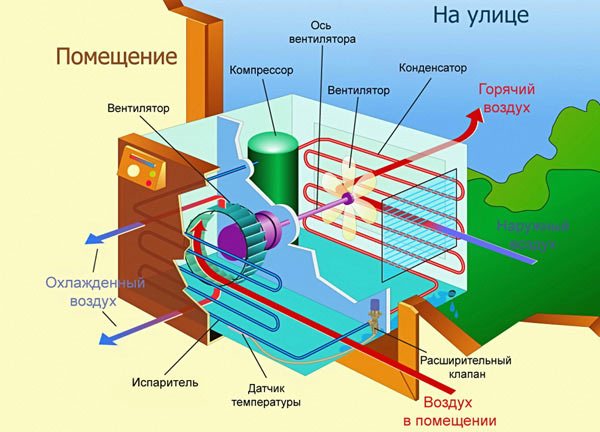

Power differences
This issue has already been touched upon earlier. Now more about this.When choosing a split technology or other cooling device, it must be borne in mind that this is a special equipment. According to power criteria, it differs from electric heating units. The power consumption of an air conditioner, generated from electricity, differs from its MO.
In this example, the result is 2.67 kW per 20 sq. M. He may confuse some owners. But the efficiency of such units is quite high due to the steam generation and condensation of freon (it is a working fluid). And in fact, the apparatus absorbs three times less electricity. Thus, it is necessary to divide the indicator 2.67 by 3. That is how much 0.89 kW consumes in this case.
How to choose the type of air conditioner
What type of air conditioner is best for your home? (Wall-mounted split system, multi-split system, duct air conditioner, ceiling air conditioner, mini chiller or mini VRF system)
A professional contractor will conduct a preliminary assessment of all the necessary parameters of your home and discuss with you the required functionality of the air conditioning system. Based on these data, it will already be possible to voice some tips about which type of air conditioning system is best suited for your home. For example, for a small room without a forced ventilation system, the best option would be to install a simple wall-mounted split system. If you need to condition several rooms at once, and there is no possibility of installing several outdoor units for a number of reasons (this is especially important in St. Petersburg due to the need to agree on the installation locations of outdoor air conditioner units in the KGA), then in this case, a multi-split system is well suited. A representative of a company that sells and installs air conditioners will answer any question you may have regarding the use of wall, ceiling or duct split systems, multi split systems, mini central air conditioning systems, and, if necessary, additional heating - heat pumps.
In most cases when looking for air conditioners, a conventional split system with one outdoor unit and one wall-mounted indoor unit will do. But there are frequent cases of requests and various options for the execution of indoor units. We invite you to get to know them.
| Air conditioners - Split systems | Multi-split | Multi-zone VRF systems |
| An affordable and effective solution where only one room in the house needs to be cooled, providing low noise levels and a wide range of indoor units with different types and styles of execution to choose from. | Multi-split systems are relevant for places where several indoor units are required, and at the same time it is impossible to install several outdoor units for technical or aesthetic reasons. They allow using one outdoor unit to install its own indoor unit with independent temperature control in each room. | They are mainly used to cover the air conditioning needs of entire buildings and large offices. The main difference from the first two types is a large refrigerating capacity and the ability to use a large number of indoor units (up to 100 or more, depending on the model). |
Power of devices from foreign manufacturers
Getting acquainted with the characteristics of various air conditioners, you will notice that manufacturers do not indicate their power in kilowatts. For power, manufacturers indicate numbers. The most common are seven or nine.
What do these values mean? Equipment power is indicated in BTU (British Thermal Units). 1 BTU = 0.3 W. Often, the parameters of British thermal units can be observed in the names of air conditioners.
Power of 2 kW corresponds to 7000 BTU (model "seven")
Power 2.5 kW - 9000 BTU (model "nine")
3.5 kW - 12000 BTU (twelfth model).
Power selection based on British thermal units:
- For rooms with an area of 15 - 20 sq. M suitable models "seven"
- Premises with an area of 20 to 30 square meters correspond to model 9 or 12
An example of calculating the capacity for a standard apartment with an area of 60 sq.m .:
The area of each room in the room should be calculated. If the apartment has 3 rooms with an area of 20, 15 and 25 square meters, then the optimal solution would be to choose two air conditioners with a capacity of 7 and one with a capacity of 9.

